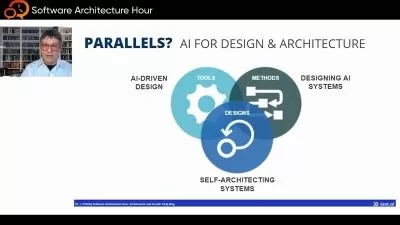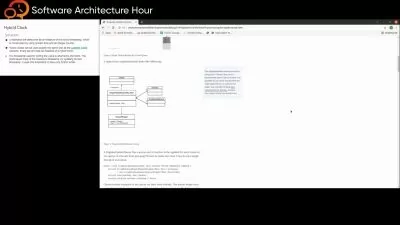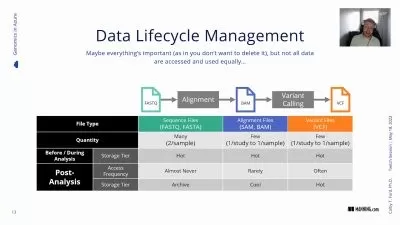Software Mistakes And Tradeoffs, Video Edition
Focused View
13:57:02
65 View
001. Chapter 1. Introduction.mp4
11:48
002. Chapter 1. Code design patterns and why they do not always work.mp4
10:49
003. Chapter 1. Architecture design patterns and why they do not always work.mp4
09:39
004. Chapter 2. Code duplication is not always bad Code duplication vs. flexibility.mp4
08:41
005. Chapter 2. Libraries and sharing code between codebases.mp4
08:58
006. Chapter 2. Code extraction to a separate microservice.mp4
07:57
007. Chapter 2. Looking at the tradeoffs and disadvantages of a separate service.mp4
08:53
008. Chapter 2. Improving loose coupling by code duplication.mp4
07:44
009. Chapter 2. Looking at inheritance and tight coupling.mp4
09:40
010. Chapter 3. Exceptions vs. other patterns of handling errors in your code.mp4
11:24
011. Chapter 3. Best patterns to handle exceptions in the code that you own.mp4
08:16
012. Chapter 3. Anti-patterns in exception handling.mp4
08:26
013. Chapter 3. Exceptions from third-party libraries.mp4
06:38
014. Chapter 3. Exceptions in multithread environments.mp4
08:45
015. Chapter 3. Functional approach to handling errors with Try.mp4
07:46
016. Chapter 3. Using Try in production code.mp4
07:09
017. Chapter 3. Performance comparison of exception-handling code.mp4
07:41
018. Chapter 4. Balancing flexibility and complexity.mp4
09:11
019. Chapter 4. Allowing clients to provide their own metrics framework.mp4
08:33
020. Chapter 4. Guarding against unpredictable usage of the hooks API.mp4
09:53
021. Chapter 4. Providing extensibility of your APIs via listeners.mp4
07:56
022. Chapter 4. Flexibility analysis of an API vs. the cost of maintenance.mp4
05:33
023. Chapter 5. Premature optimization vs. optimizing the hot path Decisions that impact code performance.mp4
06:52
024. Chapter 5. Optimizing processing based on false assumptions.mp4
07:27
025. Chapter 5. Hot paths in your code.mp4
09:13
026. Chapter 5. A word service with a potential hot path.mp4
06:24
027. Chapter 5. Hot path detection in your code.mp4
11:05
028. Chapter 5. Improvements for hot path performance.mp4
09:19
029. Chapter 5. Optimizing word exists using a cache.mp4
09:08
030. Chapter 6. Simplicity vs. cost of maintenance for your API.mp4
12:33
031. Chapter 6. Directly exposing settings of a dependent library.mp4
10:21
032. Chapter 6. Adding new setting for the cloud client library.mp4
07:51
033. Chapter 6. Deprecatingremoving a setting in the cloud client library.mp4
11:56
034. Chapter 7. Working effectively with date and time data.mp4
06:34
035. Chapter 7. Machine time Instants, epochs, and durations.mp4
06:46
036. Chapter 7. Civil time Calendar systems, dates, times, and periods Part 1.mp4
07:28
037. Chapter 7. Civil time Calendar systems, dates, times, and periods Part 2.mp4
07:28
038. Chapter 7. Time zones, UTC, and offsets from UTC Part 1.mp4
06:53
039. Chapter 7. Time zones, UTC, and offsets from UTC Part 2.mp4
08:34
040. Chapter 7. Date and time concepts that hurt my head.mp4
06:25
041. Chapter 7. Preparing to work with date and time information.mp4
05:44
042. Chapter 7. Clarifying date and time requirements Part 1.mp4
07:43
043. Chapter 7. Clarifying date and time requirements Part 2.mp4
07:22
044. Chapter 7. Using the right libraries or packages.mp4
11:46
045. Chapter 7. Improving testability by avoiding defaults Part 1.mp4
07:44
046. Chapter 7. Improving testability by avoiding defaults Part 2.mp4
05:54
047. Chapter 7. Representing date and time values in text Part 1.mp4
09:40
048. Chapter 7. Representing date and time values in text Part 2.mp4
09:32
049. Chapter 7. Explaining code with comments.mp4
08:17
050. Chapter 7. Handling ambiguous or skipped times.mp4
08:57
051. Chapter 8. Working with evolving time zone data.mp4
07:45
052. Chapter 8. Leveraging data locality and memory of your machines.mp4
09:38
053. Chapter 8. Data partitioning and splitting data.mp4
07:09
054. Chapter 8. Partitioning vs. sharding.mp4
08:22
055. Chapter 8. Join big data sets from multiple partitions.mp4
11:29
056. Chapter 8. Data processing Memory vs. disk.mp4
07:37
057. Chapter 8. Calculating access times.mp4
07:58
058. Chapter 8. Implement joins using Apache Spark.mp4
10:49
059. Chapter 9. Third-party libraries Libraries you use become your code.mp4
11:22
060. Chapter 9. Concurrency models and scalability.mp4
12:36
061. Chapter 9. Testability.mp4
06:00
062. Chapter 9. Testing with fakes (test double) and mocks.mp4
10:46
063. Chapter 9. Dependencies of third-party libraries.mp4
09:12
064. Chapter 9. Choosing and maintaining third-party dependencies.mp4
08:43
065. Chapter 9. Security and updates.mp4
07:09
066. Chapter 10. Consistency and atomicity in distributed systems.mp4
08:17
067. Chapter 10. Producing data and idempotency.mp4
11:23
068. Chapter 10. A naive implementation of a deduplication library.mp4
05:41
069. Chapter 10. Common mistakes when implementing deduplication in distributed systems.mp4
10:30
070. Chapter 10. Making your logic atomic to prevent race conditions.mp4
11:19
071. Chapter 11. Delivery semantics in distributed systems.mp4
10:00
072. Chapter 11. Producer and consumer applications based on Apache Kafka.mp4
08:58
073. Chapter 11. The producer logic.mp4
08:52
074. Chapter 11. Consumer code and different delivery semantics.mp4
06:08
075. Chapter 11. Restarting from the earliest or latest offsets.mp4
08:48
076. Chapter 11. Leveraging delivery guarantees to provide fault tolerance.mp4
05:22
077. Chapter 12. Managing versioning and compatibility.mp4
09:39
078. Chapter 12. Semantic versioning.mp4
09:27
079. Chapter 12. Versioning for libraries.mp4
10:55
080. Chapter 12. Source, binary, and semantic compatibility Part 1.mp4
10:17
081. Chapter 12. Source, binary, and semantic compatibility Part 2.mp4
10:37
082. Chapter 12. Techniques for handling breaking changes.mp4
11:32
083. Chapter 12. Managing internal-only libraries.mp4
11:30
084. Chapter 12. Common versioning strategies Part 1.mp4
06:45
085. Chapter 12. Common versioning strategies Part 2.mp4
06:48
086. Chapter 12. Further versioning considerations.mp4
07:42
087. Chapter 12. Versioning for data storage.mp4
08:40
088. Chapter 12. Migrating data within a storage system.mp4
07:42
089. Chapter 12. Expecting the unexpected.mp4
08:28
090. Chapter 12. Separating API and storage representations.mp4
10:33
091. Chapter 13. Keeping up to date with trends vs. cost of maintenance of your code.mp4
04:58
092. Chapter 13. Do-it-yourself (DIY) dependency injection.mp4
09:28
093. Chapter 13. When to use reactive programming.mp4
06:55
094. Chapter 13. Using CompletableFuture.mp4
07:10
095. Chapter 13. When to use functional programming.mp4
12:02
096. Chapter 13. Using lazy vs. eager evaluation.mp4
07:45
More details
User Reviews
Rating
average 0
Focused display

O'Reilly
View courses O'ReillyO'Reilly Media is an American learning company established by Tim O'Reilly that publishes books, produces tech conferences, and provides an online learning platform. Its distinctive brand features a woodcut of an animal on many of its book covers.
- language english
- Training sessions 96
- duration 13:57:02
- Release Date 2023/11/06













